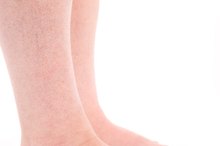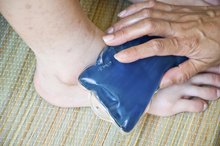What does fact checked mean?
At Healthfully, we strive to deliver objective content that is accurate and up-to-date. Our team periodically reviews articles in order to ensure content quality. The sources cited below consist of evidence from peer-reviewed journals, prominent medical organizations, academic associations, and government data.
The information contained on this site is for informational purposes only, and should not be used as a substitute for the advice of a professional health care provider. Please check with the appropriate physician regarding health questions and concerns. Although we strive to deliver accurate and up-to-date information, no guarantee to that effect is made.
How to Jog With Patellar Chondromalacia
Patellar chondromalacia is a softening or breakdown of the cartilage underneath your kneecap, according to the National Institutes of Health 3. This condition most commonly occurs in adolescents and young adults and is marked by knee tenderness, knee pain and a grinding sensation when the knee is flexed. While rest is often recommended with patellar chondromalacia, there are actions you can take to allow yourself to jog pain-free as you recover.
If you are experiencing serious medical symptoms, seek emergency treatment immediately.
Consult a doctor. Make sure your symptoms are chondromalacia and not a more serious condition, such as a cartilage or ligament tear. A physical exam, medical history and X-ray can help diagnose chondromalacia and rule out other conditions.
How to Walk on a Torn Miniscus
Learn More
Follow the instructions of your doctor. Your doctor may suggest a few weeks of rest, anti-inflammatory medications and physical therapy. Help prevent future instances of patellar chondromalacia with a knee-strengthening program, something you can use to work your hamstring and quadriceps as well.
Ask your doctor about the use of a patella strap. Use this small brace while running to help position your knee appropriately and reduce stress on the kneecap.
Rehabilitation Exercises for a Dislocated Finger
Learn More
Invest in a good pair of running shoes. The American Academy of Podiatric Sports Medicine indicates shoes should be appropriate for your jogging routine, the terrain you jog on, your body weight and your foot type 2. Shoes should have adequate shock absorption, fit snugly in the heels and have enough room in the front to allow for wiggling of the toes.
Use an arch support. Talk to your doctor about the use of an arch support in your running shoes. Arch supports can help to further reduce shock and place less stress on your knees. Arch supports can be purchased with a prescription or over the counter.
Change your jogging terrain. Switch to a softer surface to help protect your knees. Try a treadmill, track or running on wooded trails.
Ease yourself back into running slowly. The National Academy of Sports Medicine recommends increasing your training regime at a rate of 10 percent per week 12. If you normally ran two miles per day prior to diagnosis, start at two-tenths of a mile and add an additional two-tenths each week.
Tips
Listen to your body. If something does not feel right stop and rest.
Warnings
If pain persists through jogging, discontinue jogging and contact your physician.
Related Articles
References
- "National Academy of Sports Medicine: Essentials of Personal Fitness Training"; Scott Lucett; 2008
- American Academy of Podiatric Sports Medicine: Running and Your Feet
- National Institutes of Health: Chondromalacia Patella
- Habusta SF, Griffin EE. Chondromalacia Patella. [Updated 2019 Dec 10]. In: StatPearls [Internet]. Treasure Island (FL): StatPearls Publishing; 2019 Jan-.
- Caplan N, Kader DF. The Etiology of Chondromalacia Patellae. Classic Papers in Orthopaedics. July 2013:185-187. doi:10.1007/978-1-4471-5451-8_45.
- McCarthy MM, Strickland SM. Patellofemoral pain: an update on diagnostic and treatment options. Curr Rev Musculoskelet Med. 2013;6(2):188–194. doi:10.1007/s12178-013-9159-x
- Vijayalakshmi A, Sangeetha S, Ranjith N. Chondromalacia Patellae: A Review. Research Journal of Pharmacy and Technology. 2019;12(1):412. doi:10.5958/0974-360x.2019.00075.1
- Kusnezov, N.; Watts, N.; Belmont, P. et al. "Incidence and Risk Factors for Chronic Anterior Knee Pain." J Knee Surg 2016; 29(03):248-53. DOI: 10.1055/s-0035-1554921.
Tips
- Listen to your body. If something does not feel right stop and rest.
Warnings
- If pain persists through jogging, discontinue jogging and contact your physician.
Writer Bio
Michelle Zehr started writing professionally in 2009. She has written on health, fitness, fashion, interior design, home decorating,sports and finance for several websites. Zehr possesses a Bachelor of Arts in communication from the University of Pittsburgh, a Master of Arts in professional writing from Chatham University and a graduate certificate in health promotion from California University of Pennsylvania.









